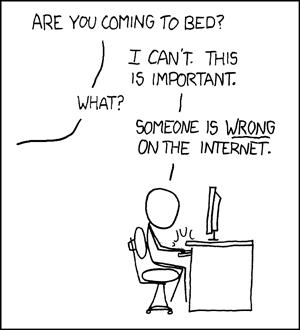This post is very rambly because, as per usual, I’m still in the phase of making sense out of things. Here we go, kids...
I don't know how I feel about blogging as a genre, as a discourse community, as a blurring of the lines between public and private life, and so on. I'm not opposed to it being parallel to what people do in their everyday lives, from putting bumper stickers on their car to holding hands in a store to talking loudly in a coffee shop. I think people want it to be more political than that, but aren't some people's cars a lot more political than others?
Here’s an example (which I hope isn’t oversharing). As a grad assistant who is in a relationship with another grad assistant, I am continually conscious of the line between private and public life. What are the lines between acceptable behavior at school (which is a public space) and acceptable behavior at a restaurant, which is also a public space, but one not directly related to our work environment? When we go to social gatherings where we will see people from school, do we behave the way we would in Milton, or the way we would if we were with friends we know outside the department?
Now, I’ve made a decision here to choose to disclose my status as “in a relationship” and give some details about the nature of that relationship, but there is some information I’ve chosen to leave out; for example, I haven’t revealed a name or gender. Those of you who know me already know who the other person is, but those who don’t will either have to ask someone or offer a lucky guess to get the scoop.
It’s hard to say that a blog is a genre when almost everyone who starts one seems to start it for different reasons. They’re journalistic in the “news to someone” sense, and they’re private journals in another. The
Miller and Shepherd piece suggests that blogging is a form of exhibitionist behavior. I’m not sure that’s the case, either.
I see a blog as another place where that line between public and private spheres needs to work itself out. There will always be someone who never talks about his or her spouse at work, and there will always be someone talking loudly in the coffeeshop about his or her latest digestive issues. The bottom line is, it’s a decision on the part of the author.
On the other hand, I liked
Steven Johnson's analogy of a blog as a "kitchen cabinet," where users have started to catalog and organize all that nutty information out there. I was a little suspicious of the notions of a blog as journalism, as in
”Blogs in Plain English”; the argument "it's news to
somebody" just doesn’t sit well with me as a form of journalism. It’s hard to say why, though. I thought for a minute that the analogy disagrees with
Herring, et.al., but “partially interconnected” is still interconnected…isn’t it?
The only issue I see with Johnson's argument is this: Herring, et.al., noted that “blogs link preferentially to A-list blogs” (10), which suggests that they’re really only filtering stuff that is already well-read. And don't all those extra blogs people have sitting around just add to the clutter of information out there?
The
Farrell piece hit on that blurred personal/professional line we’ve been talking about, and I think Farrell has a good point about using blogs as a kind of scholarly conversation. I haven’t used a blog in that way until we did so in this class, but I like it and think it could be extremely useful. However, as Herring, et.al., pointed out, that’s “the exception rather than the rule” (2).
So, back to the original question: in what ways is blogging changing and/or influencing (or not) our ways of communicating and creating/participating in community? It is giving us another forum in which to question the lines between private and public life, to challenge the ways we communicate with each other, and to open new lines between us and others. I think the real hangup in most of these readings centers upon questions about what this new medium creates
opportunities for and what actually
happens out there.


